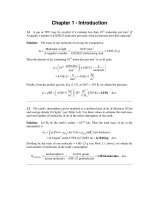1 - Introduction
Bạn đang xem bản rút gọn của tài liệu. Xem và tải ngay bản đầy đủ của tài liệu tại đây (617.4 KB, 16 trang )
1
Introduction
Thischapteroutlinestheworkingprinciplesanddevicestructuresof
semiconductorlasersasanintroductiontothecontentsofthisbook.
1.1PRINCIPLESANDDEVICESTRUCTURESOF
SEMICONDUCTORLASERS
Semiconductorlasersaredevicesforoscillationoramplificationofan
opticalwavebasedonthestimulatedemissionofphotonsthroughoptical
transitionofelectronsinasemiconductor.Theideawasproposedearly
in1957[1].Soonaftertheconstructionofthefundamentaltheoryoflasers
bySchawlowandTownes[2]in1958,followedbytheexperimental
verificationsoflaseroscillationinarubylaserandaHe–Nelaserin1960,
thepioneeringworkonsemiconductorlaserswasperformed[3–5].In1962,
pulseoscillationatalowtemperatureinthefirstsemiconductorlaser,a
GaAslaser,wasobserved[6–8].In1970,continuousoscillationatroom
temperaturewasaccomplished[9–11].Sincethen,remarkabledevelopment
hasbeenmadebythegreateffortsindifferentareasofscienceand
technology.Nowadays,semiconductorlasers[12–20]havebeenemployed
practicallyasoneofthemostimportantoptoelectronicdevicesandare
widelyusedinavarietyofapplicationsinmanyareas.
Theenergyofanelectroninanatomoramoleculetakesdiscrete
values,correspondingtoenergylevels.Considertwoenergylevelsofenergy
differenceE,andassumethattheupperlevelisoccupiedbyanelectronand
thelowerlevelisnotoccupied,asshowninFig.1.1(a).Ifanopticalwaveof
an angular frequency ! that satisfies
E ¼ hh! ð1:1Þ
is incident, the electron transition to the lower level takes place with a
transition probability, per unit time, proportional to the light intensity.
Copyright © 2004 Marcel Dekker, Inc.
Then a photon of the same mode as the incident wave, i.e., of the same
frequency and same propagation direction, is emitted. In Eq. (1.1), h is the
Planck constant and hh ¼ h/2p. In a semiconductor, the electron energy levels
are not discrete but form a band structure. Assume that there are many
electrons in the conduction band and many holes in the valence band, as
shown in Fig. 1.1(b). If an optical wave satisfies Eq. (1.1) for E slightly
larger than the bandgap energy E
g
, electron transition and photon emis-
sion take place. These phenomena are called stimulated emission. Photon
emission takes place even if there is no incident light. This emission is called
spontaneous emission.
On the other hand, if the lower level is occupied by an electron and the
upper level is unoccupied, the incident optical wave gives rise to an electron
transition in the inverse direction and absorption of an incident photon.
Quantum theory shows that the probability of the stimulated emission is the
same as that of the absorption. In a system consisting of many electrons in
thermal equilibrium, the electron energy distribution obeys Fermi–Dirac
statistics; the population of the electrons of higher energy is smaller than
that of electrons of lower energy. Therefore, as an overall effect, the optical
wave is substantially absorbed. However, if inversion of the population is
realized by excitation of the system with continuous provision of energy,
stimulated emission of photons takes place substantially, and accordingly
optical amplification is obtained. Lasers are based on this substantial
stimulated emission.
Population inversion in semiconductors can be realized by producing a
large number of electron–hole pairs by excitation of electrons in the valence
band up to the conduction band. The excitation can be accomplished by
light irradiation or electron-beam irradiation. The method of excitation
most effective for implementation of practical laser devices, however, is to
hM
Excited state
Ground state
(a) (b)
Photon
hM
Photon
Electron
Conduction band
Valence band
Electron
Hole
Figure 1.1 Schematic illustrations of stimulated emission of a photon by an optical
transition of an electron: (a) stimulated emission by an electron in an atom;
(b) stimulated emission by carriers in a semiconductor.
2 Chapter 1
Copyright © 2004 Marcel Dekker, Inc.
formap–njunctioninthesemiconductorandtoprovideforwardcurrent
throughittoinjectminoritycarriersofhighenergyinthedepletionlayer
nearthejunction.Whentheminoritycarriers,i.e.,electrons,areinjected
intothep-typeregionfromthen-typeregion,thenumberofthemajority
carriers,i.e.,holes,increasessoastosatisfyelectricalneutrality,andthe
excitationstateisobtained.Semiconductorlasersforexcitationbycurrent
injectioninthismannerarecalledinjectionlasers,diodelasers,orlaser
diodes(LD).Simpleconsiderationconcerningcarrierstatisticsshowsthat
animportantrequirementtoobtainpopulationinversionisthattheforward
biasvoltageVmustsatisfy
eV>hh!ð1:2Þ
Foralasertoamplifyanopticalwaveof830nmwavelength,forexample,
theforward-biasvoltageshouldbeV>1.5V.
Inordertooutlinetheworkingprincipleandthedevicestructureof
semiconductorlasers,asanexampleletustakeGaAslasers,whichare
representativeofsemiconductorlasersandhavethelongesthistory.The
firstoscillationofinjectionlaserswasobtainedinap–njunctionstructure
consistingofsingle-crystalmaterialGaAs,i.e.,adiodewithahomo-
structure.Thelaser,however,requiredcurrentinjectionofaverylarge
density(greaterthan50kA/cm
2
)forlasing,andthereforelasingwaslimited
topulseoscillationatlowtemperatures.Continuousoscillationatroom
temperatureandpracticalperformanceswereaccomplishedinlasersof
doubleheterostructure(DH),whichweredevelopedlater.Nowadays,
semiconductorlasersusuallymeanDHlasers.Thestructureisschematically
illustratedinFig.1.2.Thelaserstructureconsistsofalaser-activelayerof
GaAswithathicknessaround0.1mmsandwichedbetweentwolayersof
Al
x
Ga
1Àx
Aswithlargerbandgapenergyandhasdoubleheterojunctions.
ThestructureisfabricatedbymultilayerepitaxyonaGaAssubstrate.The
GaAslayerandtheAl
x
Ga
1Àx
Aslayersarecalledtheactivelayerand
claddinglayers,respectively.Thecladdinglayersarepdopedandndoped,
respectively.
TheDHstructureofferstwofunctionsthatareveryeffectivefor
reductioninthecurrentrequiredforlaseroperation.Thefirstiscarrier
confinement.AsshowninFig.1.3(a),thedifferenceinthebandgapenergy
gives rise to formation of barriers in electron potential, and therefore the
injected carriers are confined within the active layer at high densities without
diffusion from the junctions. Thus the population inversion required for light
amplification can be accomplished with current injection of relatively small
density (about 1 kA/cm
2
). The second function is optical waveguiding. The
cladding layers with larger bandgap energy are almost transparent for optical
Introduction 3
Copyright © 2004 Marcel Dekker, Inc.
Output laser light Output laser light
Injection current
Lower electrode
Upper
electrode
p-type
n-type
Rough
surface
Cleaved facet
mirror
Cladding layer
Cladding layer
Laser active layer
Figure 1.2 Structure of a DH semiconductor injection laser.
n-type
Al
x
Ga
1
_
x
As
cladding
layer
p-type
GaAs
active
layer
p-type
Al
x
Ga
1
_
x
As
cladding
layer
n-type
Al
x
Ga
1
_
x
As
cladding
layer
p-type
GaAs
active
layer
p-type
Al
x
Ga
1
_
x
As
cladding
layer
Electron energy EElectron energy E
Refractive index nOptical intensity
Thermal equilibrium state (zero bias)
Carrier injected state (forward bias)
Electron injection
Hole
injection
F
c
E
c
E
c
E
F
E
v
q
v
E
v
F
v
hM
(a) (c)
(b)
n
GaAs
n
AlGaAs
Figure 1.3 Confinement of carriers and optical wave in a DH semiconductor laser:
(a) energy band diagram; (b) refractive index distribution; (c) optical intensity
distribution.
4 Chapter 1
Copyright © 2004 Marcel Dekker, Inc.
wavelengthswhereamplificationisobtainedintheactivelayer,andthe
refractiveindexofthecladdinglayersislowerthanthatoftheactivelayer,as
showninFig.1.3(b).Accordingly,theopticalwaveisconfinedinthehigh-
indexactivelayerthroughsuccessivetotalinternalreflectionattheinterfaces
withthecladdinglayersandpropagatesalongtheplaneoftheactivelayer.
Thisformofopticalwavepropagationiscalledaguidedmode.Incontrast
withabulksemiconductorofuniformrefractiveindex,wheretheoptical
wavedivergesowingtodiffraction,theDHstructurecanguidetheoptical
waveasaguidedmode,inaregionofthethin(lessthan1mm)activelayer
withopticalgainandinitsvicinity,overalong(morethanseveralhundred
micrometres).Thustheopticalwaveisamplifiedveryeffectively.Letgbethe
amplificationgainfactorundertheassumptionthattheopticalwaveis
completelyconfinedandpropagatesintheactivelayer,letGbethecoefficient
ofreductionduetothepenetrationoftheguidedmodeintothecladding
layers,andlet
int
bethefactorrepresentingtheopticallossesdueto
absorptionandscatteringcausedbyimperfectionofthestructure.Thenthe
effectivegainintheactualDHstructureisgivenbyGgÀ
int
.
Toimplementalaseroscillatorthatgeneratesacoherentopticalwave,
itisrequiredtoprovidetheopticalamplifierwithopticalfeedback.In
semiconductorlasers,thiscanreadilybeaccomplishedbycleavingthe
semiconductorcrystalDHstructurewiththesubstratetoformapairoffacets
perpendiculartotheactivelayer.Theinterfacebetweenthesemiconductor
andtheairservesasareflectionmirrorfortheopticalwaveofaguidedmode
andgivestherequiredfeedback.Sincethesemiconductorhasahighindexof
refraction,areflectivityaslargeasapproximately35%isobtainedwitha
simplefacet.ThestructurecorrespondstoaFabry–Perotopticalresonator
(usuallyconstructedwithapairofparallelmirrors)implementedwitha
waveguide,andthereforethelaserofthistypeiscalledaFabry–Perot(FP)-
typelaser.Theopticalwaveundergoesamplificationduringcirculationinthe
structure,asshowninFig.1.4.LetRbethereflectivityofthefacetmirrors,
and L be the mirror separation; then the condition for the guided mode to
recover its original intensity after a round trip is given by
R
2
exp½2ðGg À
int
ÞL¼1 ð1:3Þ
The condition for the wave to be superimposed with the same phase after
the round trip is given by
2L ¼ mll¼
2cp
N
e
!
ð1:4Þ
where l is the optical wavelength, c the light velocity in vacuum, ! the
optical angular frequency, N
e
the effective index of refraction, and m an
Introduction 5
Copyright © 2004 Marcel Dekker, Inc.
arbitrary integer. This is the condition for positive feedback. An optical
wave of wavelength satisfying Eq. (1.4) can resonate, since the wave is
superimposed with the same phase after an arbitrary number of round trips.
When the injection current is increased and the effective gain for one of
the resonant wavelengths reaches the value satisfying Eq. (1.3), optical
power is accumulated and maintained in the resonator, and the power is
emitted through the facet mirrors. This is the laser oscillation, i.e., lasing.
The output is a coherent optical wave with only a resonant wavelength
component or components. The reflectivity of the facet mirrors is slightly
larger for the transverse electric (TE) wave (electric field vector parallel to
the active layer) than for the transverse magnetic wave (perpendicular), and
therefore FP lasers oscillate with TE polarization. The above two equations
describe the oscillation conditions, and the injection current required for
obtaining the gain satisfying these conditions is called the threshold current.
The resonator length L of typical semiconductor lasers is 300–1000 mm, and
Active layer Injection current
Upper cladding layer
Lower cladding layer
Substrate
Resonator length L
Facet mirror
(cleaved facet)
Facet mirror
(cleaved facet)
Optical
intensity
´ (1-R) ´ (1-R)
´ R ´ R
´ exp[( g
_
a)L]
G
G
´ exp[( g
_
a)L]
0 Lz
(a)
(b)
Figure 1.4 Circulation of optical wave in a FP semiconductor laser: (a) cross
section including the optical axis; (b) distribution of guided wave power.
6 Chapter 1
Copyright © 2004 Marcel Dekker, Inc.









